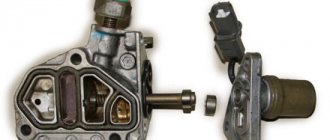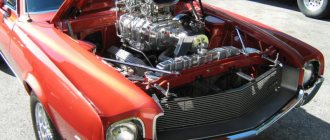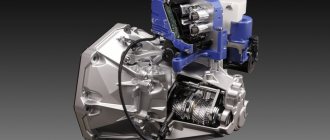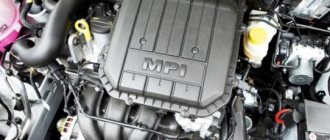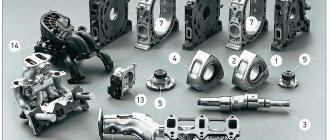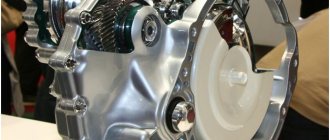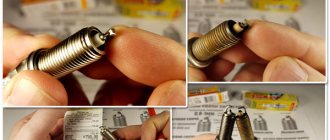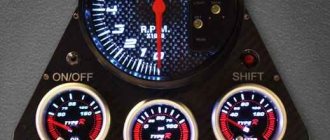The German concern Volkswagen presented the world with a new version of the gasoline engine - the FSI power unit.
It didn’t take long for this new product to win worldwide love and become popular on all continents. What kind of motor is this?
Is everything really so good with the FSI engine and is it time for the regular gasoline unit to sink into oblivion? Let's look at what German specialists have invented.
What is FSI?
Fuel Stratified Injection is an abbreviation for stratified direct fuel injection. The entire line of FSI power units is naturally aspirated with direct injection. To this day, these engines, through modernization, are installed on new VAG models, but are gradually being replaced by a more advanced line of TFSI turbo engines.
Direct injection means that the fuel system injectors are installed directly in the cylinder head, and the spray nozzle is installed in the combustion chamber (like a diesel engine). Layered injection has two circuits: a low-pressure line and a high-pressure line. To ensure idling, constant speed and coasting modes, the engine does not require a lot of fuel, so the first low pressure circuit will be activated, which includes:
- fuel tank with low pressure fuel pump;
- low pressure line;
- fuel filter;
- bypass valve (return);
- FTD (fuel pressure regulator).
The high pressure circuit comes into play when immediate maximum power is required. The system additionally includes:
- injection pump;
- nozzles with 6 holes (this ensures the correct spray geometry);
- distribution pipelines from the injection pump to the injectors;
- high fuel pressure sensor;
- safety valve;
- high pressure fuel line.
When the engine is running, air entering the cylinders through the throttle valve is mixed with fuel directly in the combustion chamber at the beginning of the compression stroke, when the piston moves from bottom dead center (BDC) to top. Such mixture formation is homogeneous, which allows for maximum combustion of the working mixture, which means increasing engine efficiency.
During moderate driving, or in idling mode, the fuel injection pump does not work, and fuel is supplied to the injectors at a pressure of 0.05 MPa, as soon as the gas pedal is pressed, the pressure increases to 5 MPa by turning on the high pressure fuel pump. A separate ECU and fuel pressure sensor are responsible for the flexibility of transient modes.
So, direct injection, in contrast to classic distributed injection, is distinguished by fuel efficiency, environmental friendliness, and increased power by 10-15% with the same cylinder volume.
About the disadvantages of FSI
In the process of introducing these engines into the VAG car line, the power units are constantly in modernization mode. A common drawback of all engines with direct injection is sensitivity to the quality of gasoline, the quality of air and fuel filters.
Main disadvantages:
- Annual maintenance of the fuel system is required, including diagnostics and cleaning, from the fuel tank to the injectors. Untimely cleaning of injectors can lead to serious consequences for the engine: due to a lack of fuel, the cylinder will overheat and the piston will split, and due to overflow, water hammer will occur;
- Frequent replacement of spark plugs is required, maximum every 20,000 km. Often FSI engines refuse to work stably with non-original spark plugs;
- problems with cold starts in winter due to insufficient pressure in the small circuit for the sake of reducing toxicity (the error was later corrected by introducing new firmware into the ECU);
- increased fuel consumption until the engine reaches operating temperature.
Engines of 1.8 and 2 liters deserve special attention. Here, every 100,000 km, you have to remove the cylinder head and clean the valves. Due to the fact that fuel does not pass through the cylinder head channel, and therefore does not wash and cool the intake valves, they begin to actively “overgrow” with soot and carbon deposits, which can cause the valves to hang at high speeds. Symptoms such as increased oil and fuel consumption, decreased power and traction, as well as increased operating noise of the power unit indicate the need to remove the cylinder head and mechanically clean the valves.
Bottom line
At the time of production, FSI engines were “raw”. During their production, repeated modernization was carried out, but the main problems were not eliminated: carbon deposits on the valves, increased oil consumption after 100,000 km. Engines of this series are capricious in terms of fuel quality and maintenance, so failure to comply with regulations soon leads to expensive financial investments.
Crankcase ventilation system
The diaphragm valve of the crankcase ventilation system is located in the valve cover; crankcase gases from it move into the intake manifold through rubber tubes.
Naturally, over years of use the membrane cracks. A plastic tube can also fail - it is made of short-lived rubber, which hardens and cracks over time.
Accordingly, if there is a crack in the membrane, the engine sucks out crankcase gases more intensively. At the same time, while the engine is idling, it can be noted that the unscrewed plug is strongly suctioned to the oil filler neck. Also, in this case, the engine twitches noticeably at idle, and the instantaneous fuel consumption according to the on-board computer increases.
Instant fuel consumption increases even more if a crack appears in the tube that discharges crankcase gases into the intake manifold. That is, if, according to the on-board computer, the instantaneous idle fuel consumption has increased to 1.5-3 l/h (with the norm being 0.8 l/h), then we need to look for a crack in the parts of the VCG system.
The original VKV valve diaphragm is not sold separately, but non-original diaphragms are available for sale. Owners of cars with a 2.0 FSI engine, the anti-fungus membrane is well suited for the Chery Tiggo engine.
Characteristic
The FSI power unit is a German-made motor from the Volkswagen concern. This engine has gained popular popularity due to its high technical characteristics, as well as ease of design, repair and maintenance.
Volkswagen Passat
The abbreviation FSI stands for Fuel Stratified Injection, which translated means layer-by-layer fuel injection. Unlike the widely used TSI, the FSI does not have a turbocharger. Speaking in human language, this is a regular naturally aspirated engine, which Skoda used quite often.
FSi engine
The abbreviation TFSI stands for Turbo Fuel Stratified Injection, which means turbocharged stratified fuel injection. Unlike the widely used FSI, the TFSI is turbocharged. Speaking in human language, this is a regular naturally aspirated engine with a turbine, which Audi quite often used on the A4, A6, Q5 models.
TFSi engine
Like FSI, TFSI has increased environmental standards and efficiency. Due to the Fuel Stratified Injection system and thanks to the features of the intake manifold, fuel injection and “tamed” turbulence, the engine can operate both on an ultra-lean and on a homogeneous mixture.
Intake manifold
The intake manifold of the 2.0 FSI engine contains a spool (drum) for a mechanism for changing its length and swirl flaps that reduce the cross-section of the intake channels at low engine loads. These components serve well and do not require attention.
You can choose and buy an intake manifold for an Audi engine, an intake manifold for a Volkswagen, an intake manifold for a Seat, an intake manifold for a Skoda in our catalog of contract spare parts.
TSI engine problems
The main headache for motors in this series is the timing drive. Premature stretching and wear of the chain can cause it to slip through the teeth of the sprockets, resulting in damage to the valves and pistons. The tension regulator does not inspire confidence either, failure of which leads to the same problems.
The new 1.2 liter and 1.4 liter EA211 series engines are free of problems associated with the timing drive. The chains of these motors are replaced by timing belts.
Another problem with TSI is high oil consumption. The manufacturer set the consumption for different versions from 0.5 to 1 liter per 1000 km. Often the result of such consumption of lubricants is clogging of spark plugs.
Video - among the problems, car owners often note the unusual sound of a running TSI engine and increased oil consumption:
Phase regulator
A hydraulic phase shifter is installed on the exhaust camshaft of the 2.0 FSI engine. With a mileage of about 200,000 km, and maybe earlier, the phase shifter begins to crack in the first seconds after starting the engine. In most cases, the phase shifter is not yet worn out, and the crackling noise appears due to the fact that the oil does not fill its internal chambers quickly enough. The culprit of this problem may be the N205 control valve or the Teflon rings that seal the oil supply channels to the phase regulator.
The N205 valve may become clogged - particles of burnt oil clog its filter screens or get inside, impairing the mobility of the spool. Also, this valve often loses its seal and begins to leak oil through the electrical connector.
Teflon sealing rings are located on the “branch” of the cover covering the camshaft gears. The lifespan of these rings is very limited; they simply burst, and then the oil does not flow into the phase shifter in full. Also, these rings are easily damaged when removing the cover for the camshaft chain replacement procedure. If you do not pay attention to their damage, then a 2.0 FSI engine with a recently replaced chain may experience errors in adjusting the valve timing and the phase shifter will crack. An original set of rings is not offered specifically for the 2.0 FSI engine, but they are suitable for 2.0 TFSI engines. Today, a set of original rings (06F198107A) sells for about $30. They should be changed every time the upper timing case cover is removed.
The phase regulator is also known for the fact that the screw that secures it is very difficult to unscrew. Often you just have to drill it out. Therefore, for any manipulations with the phase shifter, it is better to stock up on its mounting screw.
If the phase regulator experiences oil starvation for a long time, it may jam and stop performing its functions. The cracking noise of the regulator after starting the engine most often occurs due to wear in the holes for the phase shifter stopper. Grooves may also appear on the phase shifter housing at the points of contact with the O-rings.
You can choose and buy a phase regulator for an Audi engine, a phase regulator for Volkswagen, a phase regulator for Seat, a phase regulator for Skoda in our catalog of contract spare parts.
Comparison of TSI and TFSI
Car enthusiasts are quite naturally interested in what is the difference between TSI and TFSI series engines, since both options are available on the market and you need to choose the best one among them.
Speaking about the difference between them, it’s worth saying right away that TSI and TFSI are built using completely different technologies.
In the case of the TSI, Volkswagen, or rather its engineers, did not use any old naturally aspirated engine as a basis. In this case, the internal combustion engine was developed from scratch. There is an intake manifold and a pair of turbines. Moreover, one turbine is of an electric type and operates, one might say, on a permanent basis. The mechanical turbine is made according to the classical design. Without going into details, the TSI can even be called a biturbo engine.
There is another important difference that allows us to say that TSI is inferior to TFSI. The latter is supported by the borrowing of the basis in the form of an atmospheric internal combustion engine, as well as its modernization
This made it possible to obtain a more reliable cylinder block design. Unfortunately, TSI does not have such an advantage. Because of this, the latter cannot always overcome the mark of 200 thousand kilometers traveled. Plus the turbines themselves are problematic. They fail and begin to create difficulties in the operation of the internal combustion engine. This becomes especially noticeable when TSI service rules are violated.
I would like to add one more point about how the TSI motor differs from the TFSI. Their development and modernization are carried out by different VAG departments. In the case of TSI, all the work is done by specialists from Volkswagen, Skoda, and Seat. It is on their engines that these internal combustion engines are mainly installed. And the TFSI became the property of the Audi brand, just like the FSI.
It is important to understand that all represented brands work together, sharing their technologies and developments. Therefore, seeing TFSI engines somewhere other than Audi models is more than realistic at present
Understanding the differences between the TSI series engines and the newer TFSI engines, it seems obvious which one to choose. After all, the difference between the internal combustion engine under consideration in terms of reliability, structural strength, efficiency and performance leaves no chance for a conditional competitor. But before you decide to buy such a power unit, it’s worth taking an objective look at its strengths and weaknesses.
Injection pump plunger pusher
Most often, the fuel injection pump of the 2.0 FSI engine has to be removed briefly to replace the pusher located on its plunger. The pushrod is a thimble cap that works on the double cam of the intake camshaft. As on other direct injection VAG engines, this cap wears out and can even be rubbed through. At the same time, the performance of the fuel injection pump decreases, and a metallic clanging sound appears.
The pushrod on the naturally aspirated 2.0 FSI engine lasts longer than on the turbocharged 2.0 TFSI, and cases of wear on the camshaft drive cam are practically unknown.
Design features
The turbocharger is mounted in the exhaust manifold housing. This is a single module. Exhaust gases are re-fed into the manifold for afterburning. The engineers also had to change the power system a little. Thus, a pump designed for higher pressure is installed in the second pumping circuit.
The fuel pump is fully regulated by an electronic unit. Therefore, the volume of the prepared fuel mixture, which will then be injected into the engine cylinders, will depend on the load on the engine. If this is necessary, the pressure will increase - the unit will give this command if the car is driving uphill in a low gear. This removes serious power from the engine and reduces fuel consumption.
EGR valve
The EGR valve on the 2.0 FSI engine has an electronic servo drive with several plastic gears in the mechanism. Over the years and kilometers of operation, the valve flap begins to jam due to soot deposits, and an error occurs in the EGR valve. In this case, it is the plastic gears that take the entire load - the teeth break off from them. If you have enough “crazy hands,” you can carry out repairs: restore broken teeth, replace a gear, or turn a gear.
Therefore, it is worth periodically removing and washing the valve flap. After removing and installing the EGR valve, it must be adapted via diagnostic software.
You can select and buy an EGR valve for an Audi engine, an EGR valve for a Volkswagen, an EGR valve for a Seat, an EGR valve for a Skoda in our catalog of contract spare parts.
Cars on which the KF engine was installed
There are several cars that have such motors. They are all from Daihatsu. These are the cars:
- Mira;
- Mira Cocoa;
- Tanto;
- Tanto Exe;
- Mov;
- Muv Conte;
- Hidget;
- Hidget Truck;
- Essay.
Most of these cars are compact passenger cars. Compared to typical sedans, they are miniature. However, some of the listed models are minibuses, and the Hidget Truck is a miniature truck.
And on all these machines the KF VE engine performed well. Despite the relatively low traction, it is sufficient for such a small truck as the Hidget Truck. It is also enough for minibuses. Needless to say, the KF engine is also perfect for passenger cars.
Valve cover gasket
The plastic valve cover is mounted on a rubber gasket. The gasket is sold as a separate part, and it needs to be changed if oil leaks appear outside the cylinder head or inside the spark plug wells.
You can choose and buy a valve cover for an Audi engine, a valve cover for Volkswagen, a valve cover for Seat, a valve cover for Skoda in our catalog of contract spare parts.
How does a TSI and FSI engine work?
FSI.
In order to better understand how a TSI engine works, let's take an example of the operation of its “brother” FSI engine. The abbreviation FSI (Fuel Stratified Injection) denotes engines developed by German specialists with so-called “stratified” fuel injection. The fuel system in this engine is designed similarly to diesel units:
The fuel pump pumps gasoline under high pressure into a fuel rail common to all cylinders. Fuel injection, controlled by a system of electromagnetic valves, is carried out using injectors. By the way, if you want to wash the injectors, this is your place. The opening of each of the nozzles occurs after a command is given by the central control unit. The operating phase depends on both engine speed and load.
FSI engine video
Advantages of the FSI engine.
The advantage of such an engine is that due to strict dosing of fuel injection into the combustion chamber, savings of up to 15% are achieved in comparison with gasoline engines equipped with a classic injection system. In addition, more uniform traction at low and medium speeds is ensured by changing the camshaft phases.
TSI.
Unlike the FSI engine, the TSI engine is a gasoline power unit with a dual turbocharging system. The abbreviation TSI (Turbo Stratified Injection) can be translated here as an engine with stratified fuel injection and turbocharging.
This engine inherited the fuel injection system from the FSI engine and received an additional mechanical compression system. Naturally, the design of such an engine is much more complex. However, this disadvantage is fully compensated by its greater reliability, power and efficiency.
TSI engine video
The layout of the TSI engine is different in that the turbocharger and mechanical compression system are located on opposite sides of the engine. A traditional turbocharged engine obtains additional power by using the energy of exhaust gases, which spin the turbine wheel through a drive system, creating compression and air injection. Compared to a classic gasoline engine, this system is more efficient, but the efficiency of the TSI engine with stratified injection and turbocharging system is much more efficient.
Advantages of the TSI engine.
The big disadvantage of a simple turbocharged engine is that it is poorly efficient at low and idle speeds. In contrast, the TSI engine has a mechanical compressor that operates at low speeds and a turbocharger that provides increased power at high speeds. Thus, additional compression and injection of air into the engine system occurs over almost the entire operating speed range. It is this factor that contributes to a multiple increase in power with reduced fuel consumption, which is provided by a metered, stratified injection system and a double injection system.
All of the above factors lead to the fact that the TSI engine, developed by the German “aces” of Volkswagen, reaches impressive power values. Thus, in comparison with a classic turbocharged engine of the same manufacturer, with a nominal engine volume of 1.2 liters, the TSI engine shows an average result of 12 hp. better (90 hp for the turbo engine vs. 102 hp for the TSI engine). In addition, the dual compression system results in no power loss and excellent traction, both at low and high engine speeds.
Naturally, the complexity of the engine design could not but affect its price. But the slight increase in price is fully compensated by the reduced level of consumption and increased power.
Anti-lock braking system
Oil pressure sensor VAZ 2106.
What is better: automatic or robot?
Mercedes classes.
FSI technology direct fuel injection into the engine
Installation with direct fuel injection or what is an FSI engine? Today, the choice of road transport is quite wide, unlike ten years ago, when humanity actually knew two types: gasoline and diesel. Of course, they became the prototype for all subsequent ones, since new species have not yet been invented. Except for the engine on a hybrid basis, when diesel and electric work together. More and more often you can see TSI and FSI markings on the trunk of cars. The average person has no idea what these abbreviations stand for. In fact, a lot depends on the type of engine with which the car is chosen, including the amount of pleasure. To broaden our horizons, let’s consider previously unfamiliar markings.
Characteristic
Since the invention of gasoline engines, designers and engineers have been trying to solve the issue of high efficiency. In the 20th century, many successful design solutions were made in this area. In the 90s, Japanese automakers introduced direct fuel injection. The peculiarity is that the nozzle is installed directly in the cylinder. But then GDI, as the technology was called, did not become widespread, since operating engines with it was quite expensive, and the increase in power and efficiency was only minimally increased. However, this system was taken as the basis for the invention of new injection systems, and today we are seeing the emergence of new, more efficient power units.
Unlike Japan, Europe came to similar decisions only in the early 2000s. The work on creating effective direct injection was carried out by engineers from the VAG group. During development, experts analyzed the mistakes and experience of Japanese engine builders, after which the FSI engine was born. What it is is already clear from the name. Unlike GDI, FSI uses so-called layer-by-layer injection.
The design is reminiscent of the Japanese GDI, but VAG engineers were able to add an electronic fuel mixture control system. Yes, due to this the engine turned out to be more complex, but in the end the power and efficiency increased to 15%, and this is already a solid figure.
The abbreviation FSI or Fuel Stratified Injection stands for layered fuel injection. One of the main differences from all past technologies is the lack of turbocharging. In this line, the company offers only atmospheric power units.
Using a pump that creates high pressure in the fuel system, gasoline immediately enters the cylinders. Injection is carried out by special nozzles with six calibrated holes. Due to these holes, gasoline is distributed throughout the cylinder as evenly as possible. The fuel mixture is prepared thanks to the presence of electronically controlled air dampers. Due to this, the mixture is more homogeneous and burns with maximum efficiency. This is what environmental friendliness, safety and increased power are built on.
Electronic systems control engine operation so that the most precise amount of fuel enters the combustion chambers. There is also a double injection function - here the mixture can be distributed between strokes. This function is very useful when performing a cold start, for example in winter. The mixture is enriched until the engine and catalyst are completely heated.
Another important nuance is the presence of a fuel injection pump in the FSI engine. What this is, owners of diesel units know well.
Poor starting in severe frost
A considerable part of cars with a 2.0 FSI engine with the BVY index suffer from poor starting in severe frosts, although many cars start completely normally even in a 30-degree engine.
It is believed that when the temperature drops below -17°, the ECU prepares a too rich air-fuel mixture, which floods the spark plugs.
The most effective solution to the cold start problem is to trick the coolant temperature sensor, thanks to which the ECU “sees” a sufficiently warm engine and does not flood the spark plugs.
The snag is a resistor or variable resistor with a resistance of about 50 kOhm, soldered in parallel to the coolant temperature sensor, the sensitive element of which is the resistor. Thus, the overall resistance is reduced, the ECU “sees” that the antifreeze temperature is at least +5°, and does not overthink the composition of the fuel mixture.
The temperature sensor is tricked with a switch so that it is activated only before a cold start. And the required resistance of the variable resistor can be set by turning on the climate control service mode: on its right display you can display readings from the coolant temperature sensor (for this you need to select channel 19.2). In this mode, you can rotate the resistor, “increasing” the temperature of the antifreeze
History of TSI engines
The story dates back to 2004, when engineers equipped a new, by the standards of that time, naturally aspirated engine with direct injection (FSI) with a turbocharger. At the beginning of production, the line of these engines received the TFSI index, but a little later Volkswagen shortened the name to TSI. But on Audi cars this line of engines has retained its historical name to this day.
The main difference between the TSI series engines and the rest is the presence of both a turbine and a supercharger at the same time. The appearance on the market of the first cars equipped with TSI and TFSI engines gave rise to many myths and many skeptics appeared, claiming that the design was unreliable and inappropriate. It must be said that there is a certain truth in the words of skeptics, because there is a well-known saying that the more complex the design and the more parts it contains, the lower the level of its reliability. The first cars with TSI engines that saw the light of day could not boast of high reliability and had a number of problems associated with the timing mechanism. In addition, TSI engines are very picky about the quality of fuel and lubricants and love to “eat oil”, which is not surprising, because oil consumption in turbocharged cars is a common occurrence.
As inexorable statistics show, the reliability of power units of the TSI (TFSI) line, or rather their accompanying units, in fact, does not occupy the highest position. However, nothing is ideal and the capriciousness of such technologically advanced engines is due to other positive aspects, such as:
- efficiency;
- environmental friendliness;
- high power and torque for a small engine size;
- smooth torque plateau and excellent external speed characteristics (VSCH);
- small dimensions and weight of the entire engine structure.
Gasoline pump
Cars with a 2.0 FSI engine often experience a fuel pump malfunction. If the performance of the fuel pump frankly decreases, then an error occurs - the pressure sensor in the low circuit “sees” insufficient pressure.
But most often the fuel pump operates at reduced power without fault codes appearing. In this case, a lack of power may be felt and, most often, the engine stalls at idle. Engine stalls and inability to start occur when the engine warms up or in extreme heat. After cooling down or refueling with cold fuel (at a gas station), the engine starts.
The original fuel pump costs about $400 (3AA919051L for Passat B6 2.0 FSI), but there are much cheaper offers from Chinese manufacturers.
You can choose and buy a fuel pump for Audi, a fuel pump for VW, a fuel pump for Skoda, a fuel pump for Seat in our catalog of contract engines.
Flaws
Now let's look at the disadvantages of the FSI engine. We already know what it is - this is a motor that uses layer-by-layer injection. There are disadvantages, despite the fact that the unit does have higher power with reduced fuel consumption. The thing is that the engine, due to its design features, is very demanding not only in terms of fuel quality, but also requires better maintenance. In order for the power unit to operate without breakdowns, the owner must closely monitor it.
The first disadvantage is the location of the injectors in the cylinders. This design, even if we take into account that the engine is powered only by expensive, high-quality fuel from branded gas stations, is more susceptible to contamination. This entails significant interruptions in the operation of the motor:
- difficult starting;
- misfires;
- tripling;
- high consumption.
In critical situations, irreversible consequences may occur, which lead to expensive repairs, or even replacement of the Volkswagen engine.
To avoid clogging of the injectors, frequent preventative cleaning is necessary. Naturally, their constant removal and subsequent cleaning on special stands is very expensive. VAG itself recommends pouring special cleaning additives into the tank along with the fuel. The concern does not produce additives, and all products sold under the VAG brand sometimes have a very high price
The owner needs to pay attention to additives from well-known brands
Throttle valve
The throttle valve on the 2.0 FSI engine works well and has not been noticed to break down. But due to a layer of oil and soot deposits, the valve movement may be disrupted, and errors in idle speed control may occur, and if the valve is heavily dirty, an error may appear in the stabilization system, and the engine will go into emergency mode and will not develop more than 2000 rpm /min.
At the same time, the engine will twitch at idle speed, and the instantaneous “idle” fuel consumption will also increase slightly - normally it should not exceed 0.9 l/hour.
All of these problems can be resolved by cleaning the damper after removing it. There is also a recommendation to open the servo cover and apply additional lubricant.
You can choose and buy a throttle valve for an Audi engine, a throttle valve for Volkswagen, a throttle valve for Seat, a throttle valve for Skoda in our catalog of contract spare parts.
Pros and cons of using
Is everything really so perfect in the case of the FSI engine? This is hard to believe. We actually found several significant shortcomings. More about them later, but for now let’s study the advantages of such units:
- Improved injection and high fuel supply efficiency are thanks to the injectors, which are equipped with 6 holes.
- Uniform combustion of the fuel mixture and durability of the piston system are ensured by separate air supply to the cylinders.
- High environmental performance and economical fuel consumption (per 100 km savings can reach 2.5 liters of gasoline).
The operating principle of the FSI motor, its distinctive features
- The operating principle of the FSI motor, its distinctive features
- FSI engine operation diagram
- Engine design
- Low pressure circuit
- High pressure circuit
- Engine advantages
The FSI engine became a technological innovation in automobile production. This is a Japanese development. The original name was GDI (gasoline direct injection). But VW took this development as a basis, and now FSI engines are rolling off the assembly line. FSI meaning: engine with direct fuel injection into the cylinders. The advanced FSI technology is actively used by car manufacturers Audi and Mercedes.
- FSI engine operation diagram
- Engine design Low pressure circuit
- High pressure circuit
